Background and Objectives: Hypertension, especially in elderly is a strong risk factor for cardiovascular mortality and morbidity. Oxidative stress has been implicated as one of the underlying cause of hypertension. Yoga has been found to control hypertension in the elderly, but the underlying benefits of mechanism in relation to oxidative stress regulation remains unclear. The purpose of the study was to investigate the effect of yoga on oxidative stress in elderly with Grade-I hypertension.
Methods: An open parallel-arm randomised controlled study was conducted at BLDE University’s Shri B.M.Patil Medical College, Hospital and Research Centre, India on elderly male individuals with Grade-I hypertension (n=57, age 60-80 years). Study (Yoga) group was assigned for yoga intervention and control group for walking for one hour in the morning for six days in a week for three months under the supervision of yoga instructor and physical training instructor respectively. Serum malondialdehyde (MDA) as an indicator of oxidative stress and antioxidants such as serum superoxide dismutase (SOD), reduced glutathione (GSH) and vitamin C levels were estimated.
Results: Yoga practice for three months has significantly reduced serum MDA level (p<0.001), and enhanced antioxidants level such as SOD activity (p=0.007), serum GSH (p=0.002) and vitamin C (p=0.002). In the control group, we observed a significant increase in serum MDA level (p=0.04) and reduction in serum vitamin C level (p=0.015) with no significant difference in the SOD activity and GSH level.
Conclusion: These findings suggest that yoga is an effective means to reduce oxidative stress and to improve antioxidant defense in elderly hypertensive individuals.
Introduction
Ageing is an established cardiovascular (CV) risk factor. Hypertension is becoming an important medical and public health problem all over the world and is found to be one of the common disorders of ageing [1]. According to World Health Organization (WHO), the most common cause of preventable death in developed countries is hypertension, which is significantly increasing in developing countries [2] . There are diverse mechanisms and age-related factors involved in the development of hypertension in older individuals. Oxidative stress has been implicated as one of the underlying cause of hypertension [3-6]. An increase in the production of reactive oxygen species (ROS) such as superoxide radicals (O2), hydrogen peroxide (H2O2), hydroxyl radical (•OH), and singlet oxygen causes oxidative stress. Although, ROS are generated in multiple compartments and by multiple enzymes within the cell, but the majority of ROS are produced within the mitochondria during ATP production by oxidative phosphorylation contributing to aging and age-related disorders. If ROS are not removed or neutralized, it can target various cellular constituents like lipid membranes, proteins, DNA and RNA. Our body has evolved complex antioxidant defense mechanism to prevent the deleterious effects of ROS. An imbalance between ROS and antioxidants results in oxidative stress [7]. Oxidative stress contributes to inactivation of nitric oxide, a potent vasodilator, resulting in its decreased bioavailability and endothelial dysfunction [8,9]. Endothelial dysfunction associated with decreased nitric oxide production results in impaired vasodilation and increased blood pressure (BP) [10].
Physical activity and exercise have many beneficial effects for maintaining health, preventing age-related chronic diseases and improving quality of life of older adults [11-13]. However, the optimal amount of exercise for achieving health benefits in the elderly individuals is still unknown. On the other hand, exercise when performed strenuously or even moderately by elderly individuals, is associated with increased production of ROS and oxidative stress [14]. Yoga is another life-style modality, which has well-established health benefits. Yoga has been found to control hypertension in the elderly [15], but the underlying benefits of mechanism in relation to oxidative stress regulation remains unclear. The aim of the present study was to determine the effect of yoga on oxidative stress in elderly with Grade-I hypertension.
Materials and Methods
Study design
This open parallel-group randomised controlled study was conducted on elderly male subjects with Grade-I hypertension (n=57) between 60 to 80 years, in BLDE University’s Shri B.M.Patil Medical College, Hospital and Research Centre, India. Subjects with systolic blood pressure (SBP) from 140-159 mmHg and diastolic blood pressure (DBP) from 90-99 mmHg were categorised as Grade-I hypertension as per 2007 guidelines of the European Society of Hypertension (ESH) and of the European Society of Cardiology (ESC) [16]. Subjects on any medications and subjects with CV risk factors such as diabetes mellitus, hypercholesterolemia and high triglyceride level were excluded from the study. The study was approved by the institutional ethical committee of BLDE University’s Sri B.M.Patil Medical College, Hospital and Research Centre as per the guidelines (2006) of Indian Council of Medical Research and informed written consent was obtained for participation in the study. The declaration of Helsinki has been followed during the entire study. The study has been reported as per CONSORT declaration [17].
Study protocol
Screening of elderly individuals attending geriatric clinic above 60 yrs for Grade-I hypertension was done and were selected after thorough examination as per our inclusion and exclusion criteria. As BP is more variable in older people, the diagnosis of hypertension was made by taking nine BP readings on three separate visits [18]. Brachial BP was measured three times with an interval of one minute on a visit for three consecutive days in a sitting posture using mercury sphygmomanometer (Diamond, Industrial Electronic and Allied Products, India) [19]. Selected subjects were randomly divided into yoga group (n=30) and control group (n=30) by using random number table.
The yoga group was assigned for yoga practice under the supervision of yoga instructor for six days in a week for one hour daily in the morning from 06:00 to 07:00 hours for three months. The integrated yoga module for intervention includes: Opening prayer (1min); Sukshma Vyayama or loosening practices (5 min); Breathing practices like Hands in and out breathing, Ankle stretch breathing, Straight leg raising breathing, Lumbar stretch breathing (5 min); Asanas or maintaining postures such as Padhastasana, Ardhachakrasana, Shashankasana, Ardha Ustrasana, Bhujangasana, Ardha Salabasana and Trikonasana (15 min); Pranayama or breathing exercises such as Anuloma Viloma Pranayama and Brahmari Pranayama (5 min); Cyclic meditation, a yoga based guided relaxation technique [20]; Devotional session (5min); and Closing prayer (1 min). The protocol for control group includes flexibility or stretching practices for 15-20 min followed by walking for 35-40 min and rest for 5 min for six days in a week, for one hour in the morning between 06:00 to 7.00 hours for three months under the supervision of an authorised instructor.
The recordings were made twice, one at baseline and another after three months of intervention in the morning between 08:00 to 11:00 hours after supine rest for 10 min. On the day of investigation, no intervention was given to the participants. Person’s handling data analysis were kept blinded.
The participant flow during the study is shown in[Table/Fig-1]. Two participants from the yoga group and one participant from the walking group attended the respective training in the morning regularly but did not appear for the post-interventional investigation due to domestic reasons. Hence, they were not included in the final analysis.
Assessment of oxidative stress and antioxidant status
The blood sample was collected through venous puncture in the morning with overnight fasting for estimation of biochemical parameters. Serum malondialdehyde (MDA), a marker of oxidative stress was estimated by Kei Satoh method [21]. Antioxidants such as reduced glutathione (GSH) was estimated by Beutler E et al., method [22]; Serum vitamin C by 2,4-dinitrophenylhydrazine method [23,24]; and superoxide dismutase (SOD) activity was measured by Marklund and Marklund method [25].
Estimation of blood glucose and lipid profile
Commercial kits from Erba-Mannheim were used for estimation of fasting blood glucose (Trinder’s method), serum triglyceride (GPO-PAP method), serum cholesterol (CHOD-PAP method) and HDL cholesterol (phosphotungstic acid method).
Statistical Analysis
The obtained data was expressed as mean and standard deviation. Paired t-test for normally distributed data and Wilcoxon signed rank test for non-normally distributed data was applied for determination of statistical significance. Statistical significance was established at p< 0.05. SPSS software version 20 was used for data analysis.
Results
[Table/Fig-2] shows the baseline characteristics of yoga and control group participants. There was no significant difference in the characteristics of participants between two groups suggesting an equal distribution. The baseline values of fasting blood glucose, serum triglyceride, total cholesterol and HDL cholesterol were within the normal range in all the participants.
Yoga practice for three months has significantly reduced serum MDA level (p<0.001) in elderly participants, where as in the control group, it was significantly elevated (p=0.04) [Table/Fig-3].
A significant enhancement in antioxidant capacity has been observed in yoga participants. Superoxide dismutase (SOD) activity and GSH level were significantly increased (p=0.007 and p=0.002 respectively) in yoga participants where as no such change was noticed in the control group [Table/Fig-4,5]. We have also noticed a significant increase in serum vitamin C level (p=0.002) in yoga group, while it was significantly decreased in the control group (p=0.015) following intervention [Table/Fig-6].
[Table/Fig-7] shows a significant reduction in SBP (p<0.001), PP (p<0.001) and MAP (p<0.001) in participants of yoga group, where as in the control group no such changes were noticed.
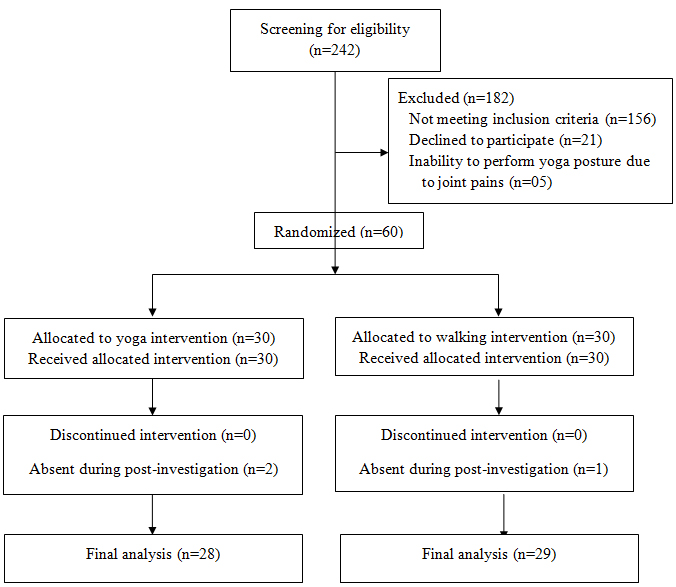
Baseline characteristics of participants
| Variable | Yoga group (n=28) | Control group (n=29) | p-Value |
| Age (Years) | 68.68 ± 4.97 | 69.17 ± 5.99 | 0.736 |
| BMI (kg/m2) | 24.65 ± 3.76 | 25.54 ± 3.41 | 0.355 |
| Systolic BP (mmHg) | 146.07 ± 5.18 | 145.72 ± 5.9 | 0.656 |
| Diastolic BP (mmHg) | 74.25 ± 4.68 | 75.52 ± 5.21 | 0.281 |
| Fasting Blood Glucose (mg/dl) | 93.50 ± 11.94 | 91.27 ± 11.89 | 0.484 |
| Serum Triglyceride (mg/dl) | 93.89 ± 26.35 | 98.90 ± 23.56 | 0.453 |
| Total Cholesterol (mg/dl) | 151.36 ± 24.72 | 153.34 ± 19.52 | 0.737 |
| HDL Cholesterol (mg/dl) | 46.75 ± 4.09 | 46.07 ± 4.34 | 0.545 |
HR- Heart rate; BMI- Body mass index; MAP - Mean arterial pressure; Values are expressed in Mean ± SD. Statistical analysis was done by students unpaired t-test.
P < 0.05 was considered statistically significant.
Comparison of serum malondialdehyde (MDA) level in yoga and control group at baseline and after 3 months of intervention.
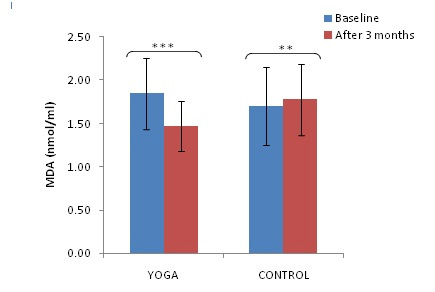
Comparison of superoxide dismutase (SOD) activity in yoga and control group at baseline and after 3 months of intervention
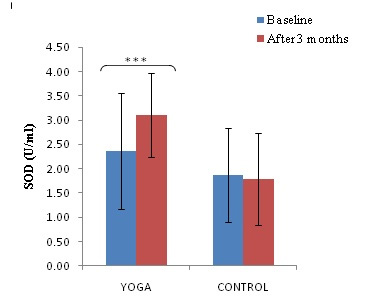
Comparison of reduced glutathione (GSH) level in yoga and control group at baseline and after 3 months of intervention
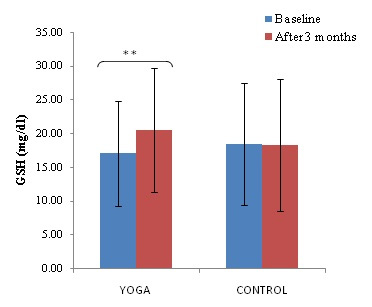
Comparison of serum vitamin C level in yoga and control group at baseline and after 3 months of intervention
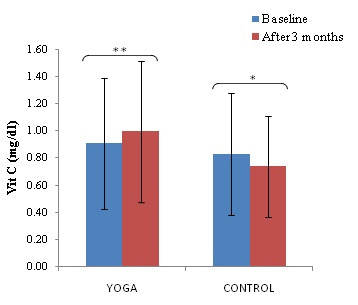
Comparison of blood pressure changes in yoga and control group at baseline and after three months of intervention
| Variable | Yoga Group (n=28) | | Control group (n=29) |
| | Before | After | Change at 3months | p-value | Before | After | Change at 3months | p-value |
| SBP (mmHg) | 146.07 ± 5.18 | 133.86 ± 7.37 | -12.21 ± 2.19 | <0.001*** | 145.72 ± 5.9 | 146.82 ± 6.03 | 1.1 ± 0.13 | 0.158 |
| DBP (mmHg) | 74.25 ± 4.68 | 73.10 ± 4.14 | -1.15 ± 0.54 | 0.216 | 75.52 ± 5.21 | 74.79 ± 4.37 | -0.73 ± 0.84 | 0.61 |
| PP (mmHg) | 71.82 ± 5.37 | 60.75 ± 7.12 | -11.07 ± 1.75 | <0.001*** | 70.20 ± 5.91 | 72.03 ± 6.95 | 1.78 ± 1.04 | 0.085 |
| MAP (mmHg) | 98.07 ± 4.20 | 93.32 ± 4.36 | -4.75 ± 0.16 | <0.001*** | 98.86 ± 4.77 | 98.34 ± 3.60 | -0.52 ± 1.11 | 0.339 |
| Values are expressed in Mean ± SD; *p<0.05, **p<0.01, ***p<0.001. Statistical analysis was done by students paired t-test and Wilcoxon signed rank test. p < 0.05 was considered statistically significant |
Discussion
Reactive oxygen species induced oxidative stress, damages the membrane polyunsaturated fatty acids resulting in generation of MDA. Elevation in serum MDA level in hypertensive subjects has been demonstrated [26]. In the present investigation, we observed a significant reduction in serum MDA level, an indicator of oxidative stress by 20.54% in yoga practitioners, which is nearly similar to the findings of Hegde et al., (20%) and Gordon et al., (19.9%) in type 2 diabetic subjects [27,28]. Conversely, we found an increase in the serum MDA in the control group. These results in control group are consistent with results reported by other studies [29,30]. In another study, Gordon et al., found reduction in oxidant level following moderate-intensity exercise for six months in individuals with type 2 diabetes [28]. According to Park J et al., mild exercise such as low-volume walking programme (30-60 minute walking session twice in a week) induce more beneficial changes in the oxidative stress in older adults than moderate-intensity exercise [31]. It may be noted in the yoga module of the present study that, we have incorporated 645 min for slow-breathing practices, relaxation technique and meditation, while for asanas (maintaining postures) 15 min was given. It is widely accepted that increased oxygen consumption during exercise results in excess generation of ROS. Whereas, yoga based relaxation technique and meditation was found to be associated with decreased oxygen consumption [32]. Hence, we presume that low consumption of oxygen during yoga practice probably reduced serum MDA level in the yoga practitioners of the present study. To the best of our knowledge, this is the first study reporting on effect of yoga on oxidative stress and antioxidant defense in elderly hypertensives.
Growing evidence indicates a strong association between oxidative stress and BP [26]. Reactive oxygen species influences cardiovascular structure and function by modulating cell growth and inflammatory responses via reduction-oxidation-dependent signaling pathways. Increased vascular oxidative stress damage the endothelium, reduces nitric oxide production by inhibiting e-NOS pathways and impairs endothelium-dependent vasodilation with resultant enhanced vascular tone and thus hypertension [5,6,8]. Further, oxidative stress causes thickening of the vascular media by promoting smooth muscle cell proliferation and hypertrophy with collagen deposition resulting in narrowing of vascular lumen [6,8]. These evidences indicate that oxidative stress may play an important role in the development of hypertension. In the present study, yoga has been found effective in reducing BP and oxidative stress in elderly individuals.
decrease in the activity of antioxidants such as SOD, catalase, glutathione, vitamins C and E may also contribute to oxidative stress [3]. Antioxidants such as SOD, catalase and glutathione act as a primary line of defense against the toxic effects of ROS. Superoxide radicals are detoxified by SOD to produce hydrogen peroxide (H2O2) which is further converted to water by catalase and glutathione peroxidase (GSPx). Glutathione peroxidase requires GSH as a coenzyme to convert H2O2 to water [33]. A negative correlation between antioxidants (such as SOD, GSH and vitamin C) and hypertension has already been reported [26]. In our study, evaluation of antioxidant status demonstrated significant increase in SOD activity by 31.35%, GSH level by 20.45% and vitamin C by 9.89% in yoga practitioners [Table/Fig-4-6]. Yoga induced enhancement in endogenous antioxidants like SOD and GSH may be due to increase in their upregulation [34] and decreased rate of utilization due to lowering of oxidative stress. Similarly, an increased level of serum vitamin C, an exogenous antioxidant, in yoga practitioners may also be due to lowering rate of utilization. This yoga induced achievement in antioxidant capacity may help to cope with deleterious effects of oxidative stress and prevents further damage to cardiovascular cells. Superoxide radicals combine with nitric oxide to form peroxynitrite leading to nitrosative stress. Yoga induced elevated SOD level may also prevent formation of peroxynitrite and thus reduces possibility of nitrosative stress.
Regular exercise has been shown to improve both exogenous and endogenous antioxidant status in animal and human studies [28,35]. However, we could not find any significant improvement in the antioxidant status of control group participants [Table/Fig-4-6]. Our results are in accordance with findings of Rosado-Perez et al., study [29]. Some studies have reported beneficial effects of moderate-intensity exercise on antioxidant system in elderly [28,36]. A significant decrease in serum vitamin C level by 10.84% was noticed in the subjects of control group [Table/Fig-6]. Reduction in vitamin C level might be due to its excessive utilization for detoxification of high levels of ROS generated in the control group subjects.
Conclusion
The findings of the study suggest that yoga can be used as an effective life-style modality to reduce oxidative stress and to enhance antioxidant defense in elderly with hypertension. Further, it is essential to develop effective physical activity strategies to reduce oxidative stress in elderly with hypertension.
Acknowledgement
We express our sincere thanks to Department of Science and Technology, Government of India and BLDE University for financial assistance. We are also thankful to all elderly volunteers for participation in the study.
HR- Heart rate; BMI- Body mass index; MAP - Mean arterial pressure; Values are expressed in Mean ± SD. Statistical analysis was done by students unpaired t-test.
P < 0.05 was considered statistically significant.
[1]. RH Fagard, Epidemiology of hypertension in the elderlyAm J Geriatr Cardiol 2002 11:23-8. [Google Scholar]
[2]. M Ezzati, AD Lopez, A Rodgers, S Van der Hoorn, CJ Murray, Comparative Risk Assessment Collaborating Group. Selected major risk factors and global and regional burden of diseaseLancet. 2002 360:1347-360. [Google Scholar]
[3]. A Ceriello, Possible role of oxidative stress in the pathogenesis of hypertensionDiabetes Care 2008 2:S181-84. [Google Scholar]
[4]. PJ Mateos-Caceres, JJ Zamorano-Leon, P Rodriquez-Sierra, C Macaya, AJ Lopez- Farre, New and old mechanism associated with hypertension in the elderlyInt J Hypertens 2012 2012(150107) [Google Scholar]
[5]. AM Briones, RM Touyz, Oxidative stress and hypertension: current conceptsCurr Hypertens Rep 2010 12:135-42. [Google Scholar]
[6]. E Grossman, Does increased oxidative stress cause hypertension?Diabetes Care 2008 31:S185-89. [Google Scholar]
[7]. R Kohen, A Nyska, Oxidation of biological systems: oxidative stress phenomena, antioxidants, redox reactions, and methods for their quantificationToxicol Pathol 2002 30:620-50. [Google Scholar]
[8]. E Schulz, T Gori, T Munzel, Oxidative stress and endothelial dysfunction in hypertension.Hypertens Res 2011 34:665-73. [Google Scholar]
[9]. BR Silva, L Pernomian, LM Bendhack, Contribution of oxidative stress to endothelial dysfunction in hypertensionFront Physiol 2012 3(441.) [Google Scholar]
[10]. RC Jin, J Loscalzo, Vascular nitric oxide: Formation and functionJ Blood Med 2010 2010:147-62. [Google Scholar]
[11]. ME Nelson, WJ Rejeski, SN Blair, JO Judge, AC King, Physical activity and public health in older adults: recommendation from the American College of Sports Medicine and the American Heart Association.Med Sci Sports Exerc. 2007 39:1435-45. [Google Scholar]
[12]. VA Cornelissen, J Arnout, P Holvoet, RH Fagard, Influence of exercise at lower and higher intensity on blood pressure and cardiovascular risk factors at older age.J Hypertens 2009 27:753-62. [Google Scholar]
[13]. GA Heckman, RS McKelvie, Cardiovascular aging and exercise in healthy older adultsClin J Sport Med 2008 18:479-85. [Google Scholar]
[14]. LL Ji, Exercise at old age: does it increase or alleviate oxidative stressAnn NY Acad Sci 2001 928:236-47. [Google Scholar]
[15]. SG Patil, G Dhanakshirur, MR Aithala, KK Das, Comparison of the effects of yoga and lifestyle modification on grade-I hypertension in elderly males: A preliminary studyInt J Clin Exp Physiol 2014 1:68-72.. [Google Scholar]
[16]. The Task force for the management of arterial hypertension of the European Society of Hypertension (ESH) and of the European Society of Cardiology (ESC). 2007 Guidelines for the management of arterial hypertensionEur Heart J. 2007 28:1462-536.. [Google Scholar]
[17]. KF Schulz, DG Altman, D Moher, Group CONSORT, CONSORT 2010 Statement: Updated Guidelines for Reporting Parallel Group Randomised TrialsPloS Med. 2010 7:e1000251. [Google Scholar]
[18]. MA Supiano, In: Hypertension., JB Halter, JG Ouslander, ME Tinetti, S Studenski, KP High, S Asthana, Hazard’s Geriatric medicine and Gerontology 2009 6th EditionNew DelhiMcGraw Hill:975-82. [Google Scholar]
[19]. TG Pickering, JE Hall, LJ Appel, BE Falkner, J Graves, MN Hill, Recommendations for blood pressure measurement in human and experimental animals: Part 1: Blood pressure measurement in humans: A statement for professionals from the subcommittee of professional and public education of the American heart association council on high blood pressure research.Hypertension. 2005 45:142-61. [Google Scholar]
[20]. S Pailoor, S Telles, A review of the scientific studies on cyclic meditationInt J Yoga 2009 2:46-8. [Google Scholar]
[21]. K Satoh, Serum lipid peroxide in cerebrovascular disorders determined by a new colorimetric methodClinica Chimica Acta 1978 90:37-43. [Google Scholar]
[22]. E Beutler, O Duron, BM Kelly, Improved method for the determination of blood glutathioneJ Lab Clin Med 1963 61:882-88. [Google Scholar]
[23]. JH Roe, CA Kuether, Determination of ascorbic acid in whole blood and urine through the 2,4-dinitrophenylhydrazine derivative of dehydroascorbic acid.J Biol Chem. 1943 147:399-407. [Google Scholar]
[24]. MA Brewster, In Vitamins., LA Kaplan, AJ Pesce, SC Kazmierczak, Clinical chemistry theory, analysis and correlation 1996 New York, USAMosby publisher:786-87. [Google Scholar]
[25]. S Marklund, G Marklund, Assay of SOD activity in tissueJ Biochem 1998 13:305-15. [Google Scholar]
[26]. R Rodrigo, H Prat, W Passalacqua, J Araya, C Guichard, JP Bachler, Relationship between oxidative stress and essential hypertension.Hypertens Res 2007 30:1159-67. [Google Scholar]
[27]. SV Hegde, P Adhikari, S Kotian, VJ Pinto, S D’Souza, V D’Souza, Effect of 3-month yoga on oxidative stress in type 2 diabetes with or without complicationsDiabetes Care. 2011 34:2208-10. [Google Scholar]
[28]. LA Gordon, EY Morrison, DA McGrowder, R Young, YT Fraser, EM Zamora, Effect of exercise therapy on lipid profile and oxidative stress indicators in patients with type 2 diabetes.BMC Complement Altern Med 2008 :8-21. [Google Scholar]
[29]. J Rosado-Perez, R Ortiz, E Santiago-Osorio, VM Mendoza-Nunez, Effect of Tai Chi versus walking on oxidative stress in Mexican older adults.Oxid Med Cell Longev. 2013 2013:2985-90. [Google Scholar]
[30]. SS Balci, N Okudan, H Pepe, H Gokbel, S Revan, F Kurtoglu, Changes in lipid peroxidation and antioxidant capacity during walking and running of the same and different intensitiesJ Strength Cond Res 2010 24:2545-50. [Google Scholar]
[31]. J Park, M Miyashita, M Takahashi, N Kawanishi, S Bae, H Kim, Effects of low-volume walking programme and vitamin E supplementation on oxidative damage and health-related variables in healthy older adultsNutr Metab (Lond). 2013 :10-38. [Google Scholar]
[32]. S Telles, SK Reddy, HR Nagendra, Oxygen consumption and respiration following two yoga relaxation techniques.Appl Psychophysiol Biofeedback 2000 25:221-27. [Google Scholar]
[33]. H Li, S Horke, U Forstermann, Oxidative stress in vascular disease and its pharmacological preventionTrends Pharmacol Sci 2013 34:313-19. [Google Scholar]
[34]. G Kojda, R Hambrecht, Molecular mechanism of vascular adaptations to exercise. Physical activity as an effective antioxidant therapy?Cardiovasc Res 2005 67:187-97. [Google Scholar]
[35]. JD Kim, BP Yu, RJ McCarter, SY Lee, JT Herlihy, Exercise and diet modulate cardiac lipid peroxidation and antioxidant defenses.Free Radic Biol Med 1996 20:83-8. [Google Scholar]
[36]. Z Radak, HY Chung, S Goto, Exercise and hormesis: oxidative stress-related adaptation for successful agingBiogerontology. 2005 6:71-5. [Google Scholar]